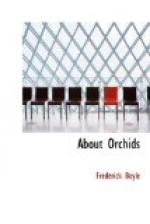Of these, and so many more, Mr. Cookson has at this moment fifteen thousand plants. Since my object is to rouse the attention of amateurs, that they may go and do likewise, I may refer lightly to a consideration which would be out of place under other circumstances. Professional growers of orchids are fond of speculating how much the Wylam collection would realize if judiciously put on the market. I shall not mention the estimates I have heard; it is enough to say they reach many, many thousands of pounds; that the difference between the highest and the lowest represents a handsome fortune. And this great sum has been earned by brains alone, without increase of expenditure, by boldness of initiative, thought, care, and patience; without special knowledge also, at the beginning, for ten years ago Mr. Cookson had no more acquaintance with orchids than is possessed by every gentleman who takes an interest in them, while his gardener the early time was both ignorant and prejudiced. This should encourage enterprise, I think—the revelation of means to earn great wealth in a delightful employment. But amateurs must be quick. Almost every professional grower of orchids is preparing to enter the field. They, however, must needs give the most of their attention to such crosses as may be confidently expected to catch the public fancy, as has been said. I advise my readers to be daring, even desperate. It is satisfactory to learn that Mr. Cookson intends to make a study of bi-generic hybridization henceforward.[9]
The common motive for crossing orchids is that, of course, which urges the florist in other realms of botany. He seeks to combine tints, forms, varied peculiarities, in a new shape. Orchids lend themselves to experiment with singular freedom, within certain limits, and their array of colours seems to invite our interference. Taking species and genera all round, yellow dominates, owing to its prevalence in the great family of Oncidium; purples and mauves stand next by reason of their supremacy among the Cattleyas. Green follows—if we admit the whole group of Epidendrums—the great majority of which are not beautiful, however. Of magenta, the rarest of natural hues, we have not a few instances. Crimson, in a thousand shades, is frequent; pure white a little rare, orange much rarer; scarlet very uncommon, and blue almost unknown, though supremely lovely in the few instances that occur. Thus the temptation to hybridize with the object of exchanging colours is peculiarly strong.




